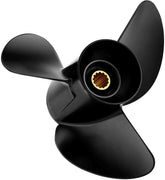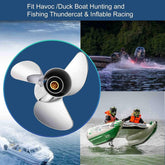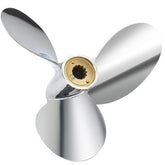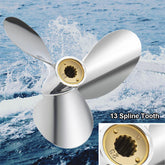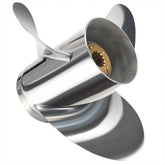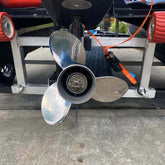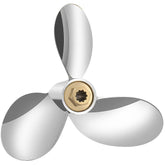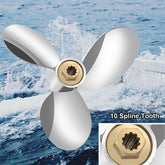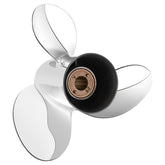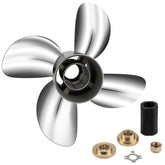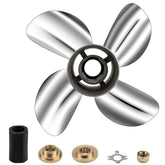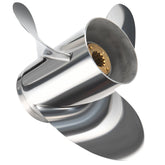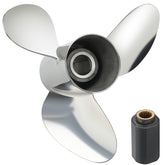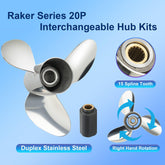Aluminum Propellers for 60-100HP Tohasu Outboard Boat Motor
Choosing the perfect propeller is much like finding the golden key that unlocks your boat’s true potential—efficiency, speed, and smooth handling. Our aluminum propellers, designed specifically for 60–100 HP Tohasu outboard boat motors, strike that balance between performance and reliability. Though not official Yamaha or Mercury products, these high-quality replicas are tailor-made to fit the gearcase dimensions and spline specifications of many popular models introduced in 2014 and later. Below, you’ll find an in-depth look at each propeller variant, complete with blade count, diameter, pitch, OEM compatibility, and rotation, all presented in a clean, easy-to-read format.
Why Aluminum Matters
When a seasoned boater weighs the pros and cons of materials, aluminum often emerges as the pragmatic choice. Here’s why:
-
Affordability Without Sacrifice
Aluminum propellers cost roughly half of their stainless-steel counterparts, yet they deliver impressive durability and performance. You won’t have to break the bank to get smooth acceleration and reliable thrust. -
Lightweight Design
Compared to stainless steel, aluminum weighs less, reducing the overall load on your engine. This translates into slightly better fuel economy and a nimble feel as you slice through the water. -
Corrosion Resistance
Our aluminum alloys are treated for extra corrosion protection. Yes, saltwater can be merciless, but these propellers hold up remarkably well—even after months of weekend saltwater excursions. -
Dampening Vibrations
Aluminum props tend to absorb shocks better than harder metals. In real terms, that means a quieter ride and less wear on your outboard’s lower unit.
That said, aluminum isn’t indestructible. If you’re willing to spring for a pricier option, stainless steel excels in extreme conditions and offers a marginal performance edge at high RPMs. But for most recreational boaters who want dependable, everyday performance, aluminum is the clear frontrunner.
Detailed Specifications
Below is a comprehensive table detailing each propeller’s key attributes: blade count, diameter (D), pitch (P), OEM number (where available), and rotation (R). If an OEM number is not listed, simply consider it as “N/A” for your reference.
| OEM Number | Blade Count | Diameter (in) | Pitch (in) | Rotation |
|---|---|---|---|---|
| N/A | 3 | 12 ¾ | 21 | R |
| 6411-130-19 | 3 | 13 | 19 | R |
| 6411-133-17 | 3 | 13 ¼ | 17 | R |
| N/A | 3 | 13 ¾ | 15 | R |
| 6411-140-09 | 3 | 14 | 9 | R |
| N/A | 3 | 14 | 10 | R |
| 6411-140-11 | 3 | 14 | 11 | R |
| N/A | 3 | 14 | 13 | R |
| 6413-125-21 | 4 | 12.5 | 19 | R |
| N/A | 4 | 13 | 17 | R |
| N/A | 4 | 13.4 | 15 | R |
| N/A | 4 | 13.8 | 10 | R |
| N/A | 4 | 13.8 | 11 | R |
| N/A | 4 | 13.8 | 13 | R |
Blade Count (B)
Every design decision—right down to the number of blades—affects how a propeller transfers engine power into forward thrust.
-
3-Blade Models
Boaters who favor a quick hole shot (rapid acceleration from a standstill) often turn to three-blade props. Their lower surface area reduces drag, meaning your boat planes faster. In our lineup, the three-blade options range from a high-pitch 21” to a more conservative 9” pitch, covering a broad spectrum of use cases. -
4-Blade Models
On the flip side, four-blade propellers typically generate more grip on the water. That extra bite is a boon for heavier boats, pontoon rigs, or anglers looking for improved hole-shot performance under load. Expect a touch less top-end speed than a comparable three-blade, but gain steadier acceleration and a smoother engagement in rough water.
Diameter (D) & Pitch (P)
Together, diameter and pitch define a propeller’s “gear ratio” relative to the water.
-
Diameter
Think of diameter as the wheel size on a car—the larger it is, the more water you push with each rotation. Too large, and you risk overloading the engine; too small, and you’ll spin at high RPMs but get little pull. The diameters in our collection range from 12 ¾ inches up to 14 inches. -
Pitch
Pitch is akin to the “step” a screw takes with each full revolution. A 21” pitch three-blade, for instance, moves theoretically 21 inches forward per revolution—assuming no slippage. High-pitch versions favor higher top speeds but require more torque to spin. Conversely, lower-pitch props (9–13 inches) allow your engine to reach optimal RPMs quicker, making them ideal for heavy loads or fishing applications where quick plane-up is essential.
Finding the sweet spot depends on your boat’s weight, hull shape, and typical operating conditions. If you haul gear or venture into choppy lakes, a smaller pitch (like the 9” or 10” options) will help you plane more rapidly. If you’re into skinny-water runs or enjoy streaming across open water, a 17”, 19”, or 21” pitch could be exactly what you need.
OEM Number (OEM#)
Where available, we list the OEM number that corresponds to a Yamaha or Mercury reference. Keep in mind: these numbers are provided strictly for cross-reference. Our propellers are aftermarket units designed to fit—but they are not produced by Yamaha, Mercury, Suzuki, Volvo, Honda, or any original equipment manufacturer.
-
6411-130-19: 3 blade, 13″ diameter, 19″ pitch, right rotation
-
6411-133-17: 3 blade, 13 ¼″ diameter, 17″ pitch, right rotation
-
6411-140-09: 3 blade, 14″ diameter, 9″ pitch, right rotation
-
6411-140-11: 3 blade, 14″ diameter, 11″ pitch, right rotation
-
6413-125-21: 4 blade, 12.5″ diameter, 19″ pitch, right rotation
Any entry marked N/A does not have an official OEM counterpart. These “no-number” options can fill specialized niches—like non-standard gearcase setups or custom applications—without compromising fit and function.
Rotation (R)
All our propellers in this series employ a right-hand (R) rotation, which is by far the most common orientation. If you’ve ever watched the prop wash in your boat’s wake, you’ll notice it spirals out to the right—that’s a right-hand propeller at work. Left-hand or dual-rotation setups exist, but our focus here is on matching the majority of Tohasu motors sold in North America.
Compatibility and Application
Our aluminum propellers are engineered for Tohasu outboard motors rated between 60 and 100 horsepower, featuring a 4 ¼" gearcase and 15-spline spline shaft. Though Tohasu is the primary focus, many of these engines share gearbox specs with 2014-newer Yamaha and Mercury counterparts—namely the BFTW60, BFW60, BFT75, BFT80, BFT90, and BFT100 series. Here’s a quick rundown of compatible engine families:
-
Tohasu Models
-
Tohasu 60–100 HP (2014 & newer)
-
4 ¼" gearcase, 15-spline
-
-
Yamaha/Mercury Equivalents
-
Yamaha BFTW60 (2014–newer)
-
Yamaha BFW60 (2014–newer)
-
Yamaha BFT75 (2014–newer)
-
Yamaha BFT80 (2014–newer)
-
Yamaha BFT90 (2014–newer)
-
Yamaha BFT100 (2014–newer)
-
Mercury F60–F100 series (2014–newer)
-
Note: Although these propellers physically fit and perform on Yamaha or Mercury motors, we do not claim official OEM status with either manufacturer. Instead, think of our units as carefully engineered after-market equivalents—built to match the critical dimensions and spline count but distinguished by cost savings and aftermarket flexibility.
How to Choose the Right Propeller
Selecting the “right” propeller can feel a bit like navigating a maze—so many variables and each boat has its own personality. Below are a few guiding principles:
-
Assess Your Load
-
Do you pack the boat with fishing gear and heavy coolers? A propeller with a lower pitch (9–13″) and 4 blades can help you plane faster under load.
-
If you travel light and crave top-end speed, a high-pitch (17–21″), 3-blade design will let your hull slice through the water with minimal drag.
-
-
Consider Your Waterway
-
Choppy lakes and rivers require a propeller that bites into the water—lean toward a 4-blade setup with moderate pitch.
-
Calm, open waters favor 3-blade, higher-pitch designs that let you relax at semi-cruise speeds without lugging the engine.
-
-
Match Engine RPM
Ideally, your engine should hover around the manufacturer’s recommended wide-open-throttle (WOT) range—often between 5,000 and 6,000 RPM for 60–100 HP outboards. If you find yourself revving too high, opt for a slightly larger pitch. If the engine struggles to reach WOT, go with a smaller pitch. -
Test and Fine-Tune
-
No chart can replace real-world experience. It’s wise to try two or three props if you want that last yard of performance or efficiency.
-
Keep a tachometer handy on your first run. If your RPMs overshoot, your pitch is too small; if you don’t hit peak RPM, the pitch is too large.
-
Installation and Maintenance Tips
Installing an aluminum propeller is straightforward, but a few simple precautions can maximize lifespan and performance:
-
Grease the Spline Shaft
Before sliding the propeller onto the shaft, apply a thin coat of marine-grade grease to prevent corrosion and ensure smooth removal later on. -
Torque the Prop Nut Correctly
Consult your engine’s manual for the precise torque specification. Too loose, and the propeller might wobble; too tight, and you risk damaging bearings. -
Inspect Regularly
Aluminum dents and dings are inevitable if you snag a submerged log or hit a shallow rock. Inspect the leading edges after each outing; minor nicks can be smoothed with a file, but severe damage often requires replacement. -
Wear Ring and Hub Check
Periodically remove the propeller to inspect the wear ring inside the gearcase. A worn ring can increase drag and sap performance. Also, check the hub for cracks—especially if you’ve taken on an abrupt impact. -
Balancing for Smoothness
After a few seasons, your aluminum prop might lose its perfect balance. If vibrations become noticeable, consider having it professionally rebalanced. A well-balanced propeller is kinder to your engine’s lower unit and your chartplotter.
Why Choose Our Propellers?
-
Precision Engineering
Each model is cast and finished to tight tolerances, ensuring you won’t encounter the sloppiness that sometimes plagues cheap off-brand props. -
Cost-Effective Performance
By focusing on aluminum construction and streamlined manufacturing, we keep prices accessible without sacrificing the build quality that seasoned boaters demand. -
Customer-Centric Support
We understand that boat owners depend on reliable gear. If you have any questions about fitment, pitch selection, or fine-tuning, our team is just a phone call or email away. -
Aftermarket Flexibility
Unlike OEM-exclusive designs, our propellers are often easier to source, and we offer a broader range of pitches for those who need a customized solution. Whether you fish, water-ski, or simply cruise, you’ll find a configuration to optimize your outing.
Putting It All Together
At the end of the day, a propeller is the conduit between your engine’s raw power and your desire to conquer the next stretch of open water. By choosing one of these aluminum propellers—whether it’s a three-blade, 13 ¼″ diameter with a 17″ pitch (OEM 6411-133-17) or a four-blade, 12.5″ diameter with a 19″ pitch (OEM 6413-125-21)—you’re investing in a piece of gear that balances cost, performance, and durability. You’ll feel the difference the moment you ease into the throttle: smoother acceleration, crisp plane-up, and confident handling even when the wake turns choppy.
In short, these propellers are your secret weapon for extracting every ounce of capability from a 60–100 HP Tohasu outboard. Remember, while the fitment overlaps with many 2014-newer Yamaha and Mercury models, our propellers remain proudly aftermarket: built by boaters for boaters. So go ahead—drop one of these aluminum beauties onto your shaft, tighten it up, and enjoy the ride you’ve always envisioned. Turbulent water, minimal fuss. That’s the aluminum advantage.


